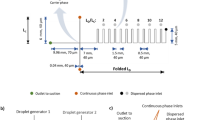Abstract
Flow rate effect on droplet formation in a co-flowing microfluidic device is investigated numerically. Transition conditions are discovered that the droplet size is either approximately independent of or strongly dependent on the flow rate ratio. This phenomenon is explained by the relation between strain rate and droplet diameter. Regions of four drop patterns are demarcated and conditions that give polydisperse drops are described, which is helpful to assure the accuracy and efficiency in droplet production.



Similar content being viewed by others
References
Ambravaneswaran B, Subramani HJ, Phillips SD, Basaran OA (2004) Dripping-jetting transitions in a dripping faucet. Phys Rev Lett 93:034501
Cramer C, Fischer P, Windhab EJ (2004) Drop formation in a co-flowing ambient fluid. Chem Eng Sci 59:3045–3058
Day D, Gu M (2005) Microchannel fabrication in PMMA based on localized heating by nanojoule high repetition rate femtosecond pulses. Opt Express 13:5939–5946
Dreyfus R, Tabeling P, Willaime H(2003) Ordered and disordered patterns in two-phase flows in microchannels. Phys Rev Lett 90:144505
Gadelhak M (2000) Flow control. Cambridge University Press, Cambridge
Ganan-Calvo AM, Gordillo JM (2001) Perfectly monodisperse microbubbling by capillary flow focusing. Phys Rev Lett 87:274501
Garstecki P, Fuerstman MJ, Whitesides GM (2005) Nonlinear dynamics of a flow-focusing bubble generator: an inverted dripping faucet. Phys Rev Lett 94:1–4
Hong YP, Li HX (2003) Comparative study of fluid dispensing modeling. IEEE Trans Electron Packag Manuf 26:273–280
Jensen MJ, Stone HA, Bruus H (2006) A numerical study of two-phase Stokes flow in an axisymmetric flow-focusing device. Phys Fluids 18:077103
Joanicot M, Ajdari A (2005) Droplet control for microfluidics. Science 309:887–888
Li D (1996) Drop size dependence of contact angles and line tensions of solid–liquid systems. Colloids Surf A 116:1–23
Nagayasu A, Uchiyama K, Kiwada H(1999) Size of liposomes: a factor which affects their targeting efficiency to tumors and therapeutic activity of liposomal antitumor drugs. Adv Drug Deliv Rev 40:75–87
Nisisako T, Toru T, Toshiro H (2003) Rapid preparation of monodispersed droplets with confluent laminar flows. Proc IEEE Micro Electro Mech Syst (MEMS) 331–334
Richards JR, Beris AN, Lenhoff AM (1995) Drop formation in liquid-liquid systems before and after jetting. Phys Fluids 7:2617–2630
Stone HA, Stroock AD, Ajdari A (2004) Engineering flows in small devices: microfluidics toward a lab-on-a-chip. Annu Rev Fluid Mech 36:381–411
Suryo R, Basaran OA (2006) Tip streaming from a liquid drop forming from a tube in a co-flowing outer fluid. Phys Fluids 18:082102
Taylor GI (1932) The viscosity of a fluid containing small drops of another fluid. Proc R Soc A 138:41–47
Thorsen T, Roberts RW, Arnold FH, Quake SR (2001) Dynamic pattern formation in a vesicle-generating microfluidic device. Phys Rev Lett 86:4163–4166
Utada AS, Lorenceau E, Link DL,Kaplan PD, Stone HA, Weitz DA (2005) Monodisperse double emulsions generated from a microcapillary device. Science 308:537–541
White FM(1991) Viscous fluid flow. McGraw-Hill, New York
Zhang X (1999) Dynamics of drop formation in viscous flows. Chem Eng Sci 54:1759–1774
Acknowledgments
The work is supported by NSFC (Project No: 10402044). We are grateful to Zhizhong Li for many inspiring discussions.
Author information
Authors and Affiliations
Corresponding author
Rights and permissions
About this article
Cite this article
Hong, Y., Wang, F. Flow rate effect on droplet control in a co-flowing microfluidic device. Microfluid Nanofluid 3, 341–346 (2007). https://doi.org/10.1007/s10404-006-0134-3
Received:
Accepted:
Published:
Issue Date:
DOI: https://doi.org/10.1007/s10404-006-0134-3




